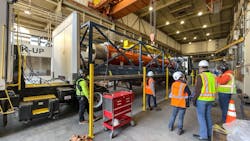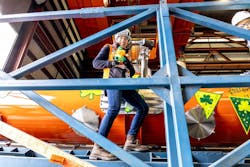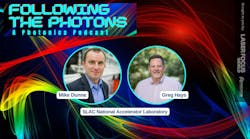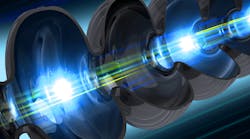SLAC LCLS-II-HE upgrade gets underway
The U.S. Department of Energy recently gave the green light to go ahead with construction for a high-energy upgrade to crank up the performance of the Linac Coherent Light Source (LCLS) at SLAC National Accelerator Laboratory. This upgrade will enable scientists to explore atomic-scale ultrafast phenomena with unprecedented precision to address fundamental questions in energy storage, catalysis, biology, materials science, and quantum physics (see video).
Last year, we talked to the LCLS team about completing their LCLS-II project, which took x-ray science to a new level that involved adding a superconducting accelerator, two undulators to generate soft and hard x-rays from the electron beam, and other cool laser advances to produce a million x-ray pulses per second—8,000x more than its predecessor.
The LCLS-II-HE upgrade is expected to be finished by 2030, with experiments possibly starting as soon as 2027.
Laser Focus World: Can you introduce us to LCLS-II-HE and describe its mission?
Greg Hays: LCLS-II-HE (Linac Coherent Light Source II High Energy) is an upgrade project to the LCLS User Facility. LCLS-II-HE will upgrade the new superconducting linear accelerator and double the electron bunch energy from 4 to 8 GeV. The accelerator upgrade will then enable x-ray generation to be extended from its current limit of 5 keV to 13 keV—into the so-called ‘hard’ x-ray domain, which more than 70% of LCLS users require. These x-rays will be delivered at up to 1 million pulses per second—an 8,000-fold increase in beam rate over the original LCLS machine.
LFW: Any cool new laser tech/advances involved? What enables doubling the electron beam’s energy?
Mike Dunne: Yes, lots! The LCLS-II project, which was completed in 2023, used 37 superconducting RF (SRF) cryomodules to accelerate up to 1 million electron bunches per second up to 4 GeV. Since LCLS-II, there have been significant advancements in SRF technology, specifically refinement of the nitrogen doping and cavity production processes. This performance enhancement will enable LCLS-II-HE to double the accelerator energy to 8 GeV with only 23 additional cryomodules.
In addition, we need to extend the performance of the optical laser systems that drive the ultrafast events that scientists study, along with the x-ray detector systems and data processing systems and sample delivery systems. There needs to be a coordinated leap in performance across all these technologies—and an integrated controls system to drive them to operate together.
LFW: What kinds of cool quantum things can you explore?
Dunne: Quantum phenomena drive much of the natural world around us—even though we can’t usually see this in action. LCLS changes this and allows us to study how electrons and atoms interact with each other—and how subtle quantum effects can change how our bodies, our technologies, and even our planet behaves!
One example is in how we manufacture something as basic as fertilizer. It turns out that the process developed by nature to make ammonia is very efficient—it’s able to happen in ambient conditions, thanks to a molecule called nitrogenase. But we humans haven’t yet figured out how to do this—we need very high temperatures and pressures in big industrial reactors. The solution is to study nature in exquisite detail, watching the pathways that are generated by biological enzymes and how the subtle quantum response of molecular interactions create such efficient chemical processes.
Another example is the development of faster computers and communications. Our society went through a revolution in the 20th century when we built microelectronics, which use electrical charge to drive information flow. There are, in principle, much faster ways to pass information that could move us from gigahertz speeds (a billion processes per second) to terahertz (a trillion) and even petahertz rates (a million billion). These would use pulses of light or quantum phenomena such as the spin of an electron. But we need to measure these effects on their natural timescales (nanoseconds down to attoseconds)—which is only possible with ultrafast lasers such as LCLS.
LFW: Can you explain why “hard” x-rays are so cool/intriguing for science?
Dunne: Hard x-rays have a short wavelength—equivalent to the size of an individual atom—so they can be used to form very high-resolution images of complex objects, such as proteins that drive how our bodies function, or next-generation microelectronics, or the inner workings of clean energy systems such as batteries, or the production of hydrogen fuel. With LCLS, these x-rays are delivered in ultrafast bursts—short enough that we can capture the formation of chemical bonds or the transfer of energy and information across a molecule. This means we can produce stop-motion movies of how these complex systems respond in real time, and study in detail how they function to help develop new pharmaceuticals, or much faster computers, or more efficient industrial processes.
LFW: Most surprising or challenging aspects of the LCLS-II-HE upgrade?
Hays: It will be a herculean challenge to upgrade the machine starting in FY26. We’ll warm up the superconducting accelerator, add 23 additional cryomodules, a new liquid helium distribution system, upgrade the hard x-ray user facility, and return the entire facility to operations within 15 months.
Leading a 10-year mega-project has been incredibly challenging. LCLS-II-HE is a collaboration of five different national laboratories spread across the country, working together to deliver a new scientific capability to the Department of Energy.
Developing a suitable beam stop for a 200-W, hard x-ray laser has been challenging. These beams like to drill through anything in their path!
LFW: Fun fact(s) about LCLS-II-HE most people don’t already know?
- There are six tons of liquid helium in the LCLS-II-HE accelerator, which is enough to fill 320,000 party balloons.
- It takes 10 MW of electrical power to cool the superconducting accelerator to 2K, which is colder than outer space.
- The cryoplant consumes 10,000 gallons of liquid nitrogen per day.
- And the maximum beam power of the LCLS-II-HE is limited administratively by the safety system to 200 W, so theoretically, the FEL could produce up to a kilowatt at 8 keV.



